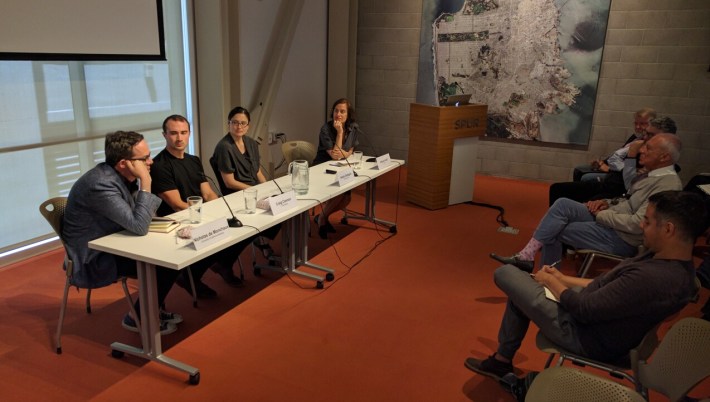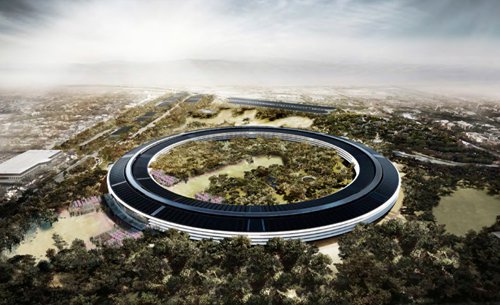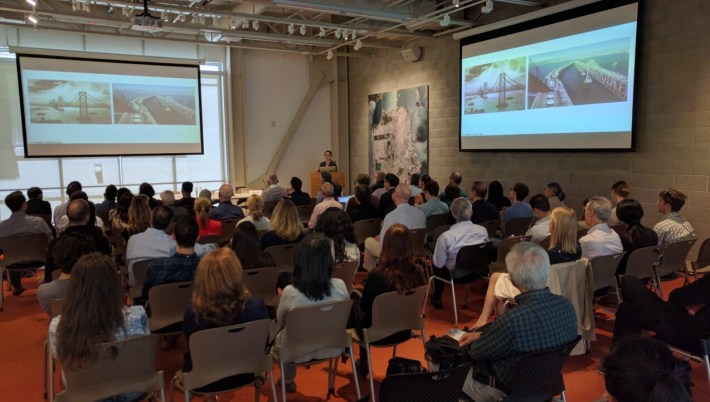
Monday afternoon the San Francisco Bay Area Planning and Urban Research Association (SPUR) hosted a lunch-time talk entitled "Designing For What We Don't Know Yet," that discussed architectural and design concepts for workplaces of the future. Some 80 people attended the panel at SPUR's Mission Street headquarters, which covered concepts ranging from building offices on and above water, to the influence of George Lucas and Star Wars on modern design.
Nataly Gattegno of Future Cities Lab started the discussion by presenting a different vision for how designers can deal with anticipated sea-level rise. "We know sea level will rise...but we don’t know by how much," she said. "So our response is to build bigger and taller and more fortified." She showed photos of concrete sea walls, but then proposed a different approach. "What if we could thrive in territory with too much water? What if we could respond with the flexibility to adapt to the unknown?"
Gattegno presented renderings of offices on piers built sufficiently above the San Francisco Bay, so that sea level rises would leave the buildings unaffected. She talked about the "Hydramax project, which proposed a series of occupy-able piers that dot the Bay."
Under this vision, transportation would be re-oriented as well. Ferries and small boats would travel right up to the buildings and take workers to and from all over the Bay Area. "We could design our architecture to actually thrive in a watery environment," she said. She also talked about a fanciful proposal to use the old Bay Bridge span for housing and offices. "With pods suspended beneath on hoists that would go up and down to the water for transportation connections," she explained.

Craig Cannon of startup-funder Y Combinator talked about jobs, work and how people will find purpose in a future of increased automation and abundance. "We’ve been raising our standards of living and increasingly demanding more of everything...and better jobs, more money, and higher expectations," he said. "We live in a world of abundance. We don’t ask: why do we need jobs?"
His company is researching that basic question and what the world will look like under a scenario where a growing percentage of people can survive without working for a paycheck. He described a study called: "Basic Income...the idea is to [see what happens] if technology replaces existing jobs and basic income becomes unnecessary," he said. "They are starting a project to give people $1,000 to $2,000 per month...will monitor [what happens] if you give people enough money that they don't have to work."
This doesn't mean, he explained, that people simply stay in bed. He cited Burning Man as evidence that when people have enough money to meet their basic needs, instead of working they often decide to create projects to find meaning. That too, the panelists explained, can have a profound influence on how cities are designed.
Last but not least, Nicholas de Monchaux, Associate Professor of Architecture and Urban Design at the University of California, Berkeley, gave a presentation on the influence of Star Wars and Steve Jobs on design, architecture, and the urban environment. Most notably, he discussed Apple's new "spaceship" inspired building in Cupertino and its similarity to the main weapon of the Death Star. He also talked about the design aesthetic of the Death Star, which took its cue from cities "You see a seemingly sleek sphere of death star slowly resolve into bits of hardware and stuff," he explained, showing images of the famous battle finale in the original Star Wars movie, when, as the fighters get closer, it is revealed that the surface of the Death Star is a city in itself. "The Death Star has urban origins."

He also pointed out that the renderings of the new Apple headquarters are a bit misleading. Although the building is pictured in a forest, in reality it is in the middle of an urban grid. "It's set behind a moat of trees, within the City of Cupertino, which has a density like Seattle."
The panelists suggested that this is a problematic symptom: there's an urge, as seen with Apple, to build isolated, suburban campuses for their workers--basically, space ships within the city and suburbs. This has even intruded into some of the projects and tech offices in SoMa. "It is a suburban model, with internal streets, internal coffee shops, as if that’s supposed to maximize creativity," said de Monchaux. "If I worked for a tech firm, I’d be happier to sneak out for a bun. I don’t think we need to reinvent and privatize the city."






